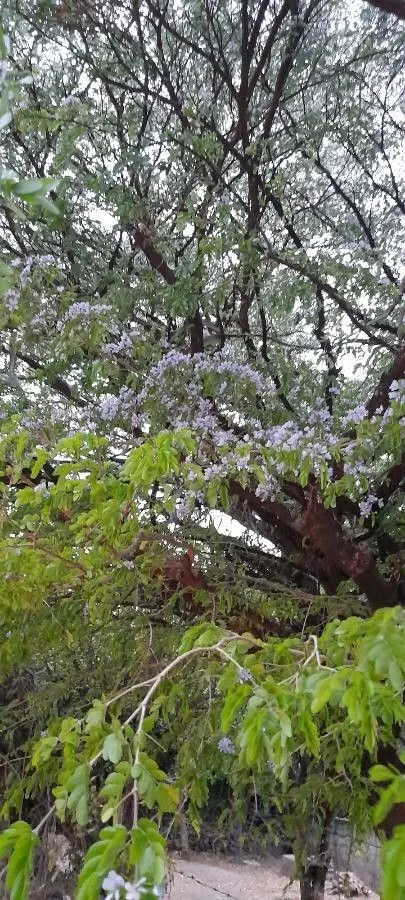
Author: L.
Bibliography: Sp. Pl.: 382 (1753)
Year: 1753
Status: accepted
Rank: species
Genus: Guaiacum
Vegetable: False
Observations: S. Mexico to C. America, Florida to Caribbean
Guaiacum, scientifically known as Guaiacum sanctum, is a noteworthy plant species belonging to the family Zygophyllaceae. This celebrated plant was first described by Carl Linnaeus in his renowned publication “Species Plantarum” in 1753, under the entry number 382. Native to regions stretching from southern Mexico to Central America, and from Florida to the Caribbean, Guaiacum thrives in these diverse yet specific climatic and geographical conditions.
Commonly referred to simply as Guaiacum, this plant has carved out a niche for itself both ecologically and culturally. It is known for its significant resilience and its ability to flourish in tropical and subtropical climates. The leaves of Guaiacum sanctum are composed of small, ovate leaflets that form a lush and dense foliage. One of the most striking features of this plant is its beautiful and vibrant flowers, which can range in color from a deep blue to a more subtle violet shade. These blossoms are not just visually appealing, but also play a vital role in the local ecosystems by attracting pollinators such as bees and butterflies.
In addition to its ecological contributions, Guaiacum sanctum has also been historically valued for its medicinal properties. The heartwood of the plant is particularly famous for producing a resin known as ‘guaiacum resin,’ which has been used traditionally to treat various ailments. This resin was once a prominent remedy for syphilis and other chronic diseases, valued for its purported detoxifying and anti-inflammatory properties.
Despite its many benefits, Guaiacum sanctum faces challenges in the wild, primarily due to deforestation and overharvesting. The dense, hard wood of the tree, often referred to as lignum vitae or “wood of life,” is highly prized for its durability and is often used in specialized applications such as tool handles, shipbuilding, and even in creating certain sports equipment. This demand has led to significant exploitation, putting the species at risk.
Conservation efforts are essential to ensure the survival of Guaiacum sanctum in its natural habitat. Sustainable harvesting practices and reforestation projects are critical strategies in protecting this valuable species. Additionally, raising awareness about the ecological and cultural significance of Guaiacum can help garner support for its preservation.
In summary, Guaiacum sanctum stands out as a botanical treasure with a compelling combination of aesthetic appeal, ecological importance, and historical relevance. It represents a fascinating blend of natural beauty and practical utility, deserving of both admiration and conservation.
Eng: holywood, guaiacum, lignum-vitae, roughbark lignumvitae, holywood lignum vitae, roughbark lignum-vitae
Swe: floridapockenholts
Nld: pokhout
Spa: guayacán, guayacán real
En: Guaiacum, Lignum-vitae, Holywood, Holywood Lignum Vitae, Bastard Lignum-vitae, Brazil Wood, Guaiacum Resin, Guaiacum Wood, Gum Guaiacum, Pockwood, Roughbark lignumvitae, Roughbark Lignum-vitae
Ar: جياك مقدس
Nl: Pokhout
Fr: Bois de Gaïac, Gayac, Guaïac, Resin de Gaïac, Resina de Guayaco
De: Franzosholz, Guajacum, Guajakharz, Guajakholz, Guajakholzbaum, Heiligenholz, Pockholz, Resina de Lenha Santo, Resina di Guaiaco, Schlangenholz
It: Guaiaco
Mr: गम ग्वायकम
Pt: Lenha di Guaiaco
Es: Guayacán real, Guayacán, Guajacum, Guayacan, Guayacancillo, Guayacán blanco, Lenha de Guayaco, Palasanto
Sv: Floridapockenholts
Taken Dec 27, 2013 by SINAC Pérez Greivin (cc-by-sa)
Taken Dec 27, 2013 by SINAC Pérez Greivin (cc-by-sa)
Taken Dec 27, 2013 by SINAC Pérez Greivin (cc-by-sa)
Taken Oct 29, 2021 by Pierre Bonnet (cc-by-sa)
Taken Apr 10, 2020 by chuc ariel (cc-by-sa)
Taken Jul 4, 2019 by Aguilar CarolinaAguilar (cc-by-sa)
Taken Nov 1, 2021 by Roy SINAC (cc-by-sa)
Taken Nov 1, 2021 by Roy SINAC (cc-by-sa)
Taken Dec 27, 2013 by SINAC Pérez Greivin (cc-by-sa)
Taken Nov 16, 2019 by Javier Valverde (cc-by-sa)
© copyright of the Board of Trustees of the Royal Botanic Gardens, Kew.
© copyright of the Board of Trustees of the Royal Botanic Gardens, Kew.
© copyright of the Board of Trustees of the Royal Botanic Gardens, Kew.
Taken Jan 1, 1900 by EOL − Daniel H. Janzen (cc-by-nc-sa)
Taken Jan 1, 1900 by EOL − Daniel H. Janzen (cc-by-nc-sa)
Taken Jan 1, 1900 by EOL − Quirico Jimenez (cc-by-nc-sa)
Taken Aug 6, 2015 by EOL − Johnny Wilson (cc-by-nc)
Taken Mar 9, 2021 by José Martí Rosales Rodríguez (cc-by-sa)
Taken Aug 6, 2022 by Anghelo Herrera Calvo (cc-by-sa)
Taken Jan 1, 1900 by EOL − Daniel H. Janzen (cc-by-nc-sa)
Taken Nov 26, 2016 by Víquez Carazo Manuel (cc-by-sa)
Taken Nov 1, 2021 by Javier García SINAC (cc-by-sa)
Taken Nov 1, 2021 by Roy SINAC (cc-by-sa)
Taken Apr 24, 2022 by Marzanna Bug (cc-by-sa)
Taken Jun 28, 2022 by Marzanna Bug (cc-by-sa)
Taken Jun 28, 2022 by Marzanna Bug (cc-by-sa)
Taken Oct 29, 2011 by EOL − Reinaldo aguilar (cc-by-nc-sa)
Taken Mar 2, 2017 by OTS – Oviedo-Brenes, Federico (cc-by-nc-sa)
Taken May 14, 2013 by OTS – Padilla, Sergio (cc-by-nc-sa)
Taken May 14, 2013 by OTS – Padilla, Sergio (cc-by-nc-sa)
Taken Mar 2, 2017 by OTS – Oviedo-Brenes, Federico (cc-by-nc-sa)
Taken Mar 2, 2017 by OTS – Oviedo-Brenes, Federico (cc-by-nc-sa)
Taken Mar 2, 2017 by OTS – Oviedo-Brenes, Federico (cc-by-nc-sa)
Growth habit>: Shrub, Tree
Growth rate>: Slow
Ph maximum: 8.5
Ph minimum: 6.0
Family: Myrtaceae Author: (F.Muell.) K.D.Hill & L.A.S.Johnson Bibliography: Telopea 6: 402 (1995) Year: 1995 Status:…
Family: Rubiaceae Author: Pierre ex A.Froehner Bibliography: Notizbl. Bot. Gart. Berlin-Dahlem 1: 237 (1897) Year:…
Family: Sapindaceae Author: Koidz. Bibliography: J. Coll. Sci. Imp. Univ. Tokyo 32(1): 38 (1911) Year:…
Family: Asteraceae Author: A.Gray Bibliography: Pacif. Railr. Rep.: 107 (1857) Year: 1857 Status: accepted Rank:…
Family: Fabaceae Author: Medik. Bibliography: Vorles. Churpfälz. Phys.-Ökon. Ges. 2: 398 (1787) Year: 1787 Status:…
Family: Aspleniaceae Author: (Cav.) Alston Bibliography: Bull. Misc. Inform. Kew 1932: 309 (1932) Year: 1932…